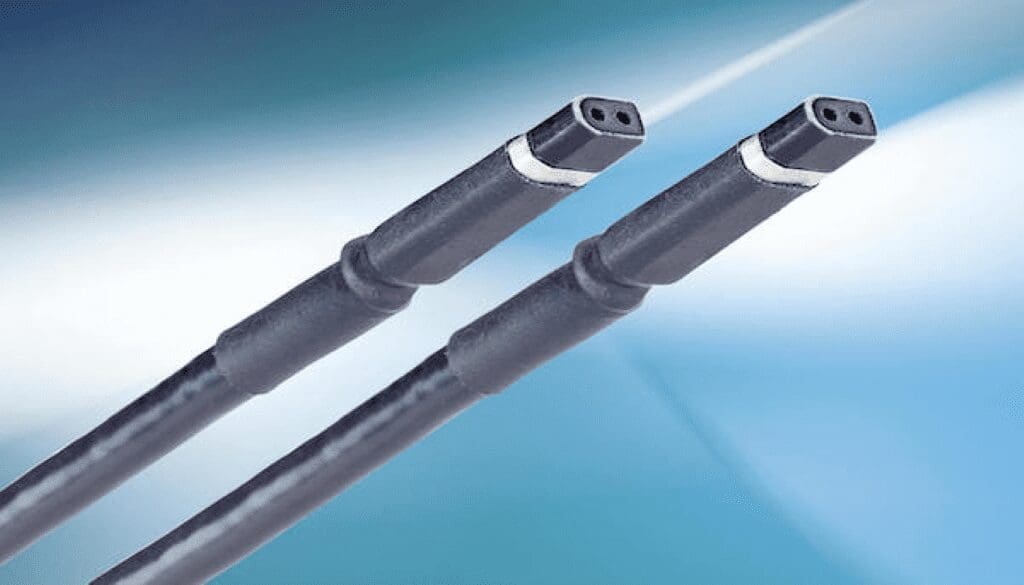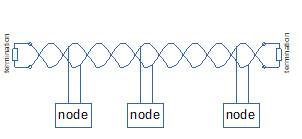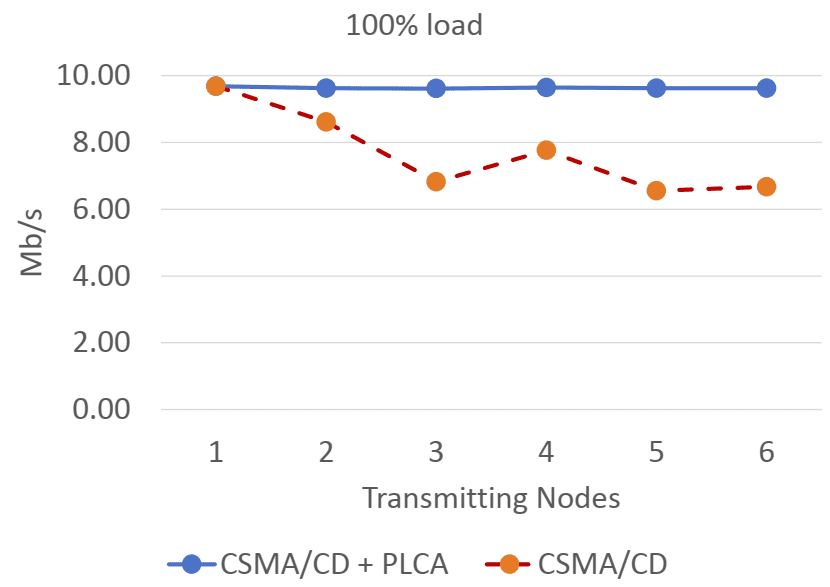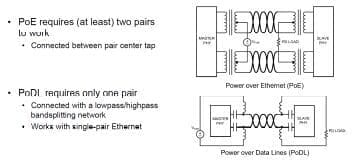Single Pair Ethernet Technology
Single Pair Ethernet expands the existing and very mature Ethernet technology with a lightweight and cost-effective option. It is ideally positioned for Industrial, Automotive, Home, and Building automation markets.
As the name indicates, Single Pair Ethernet (SPE), is a version of electrical Ethernet that only uses a single twisted pair 2-wire cable used for data. Also, power can be distributed via the same wires. This reduces costs, weight, size and facilitates easy installations.
SPE covers a wide speed range of 10Mbps up to 10Gbps and reaches up to 1000m depending on speed. The new interface is gaining rapid acceptance, as it is ideally suited to connect sensors, actuators, and control points requiring low data rates across a factory site. Another application sweet spot is the short distance connections to high-speed sensors like cameras in environments where weight and size matter such as automotive and robot systems.
The fact that SPE only uses two wires, offers simplicity and creates opportunities for dense connector and cable solutions by combining multiple interfaces. SPE comes along with a number of application-optimized and standardized robust connector systems. The cables are simple, low cost, and thinner than the standard 4- or 8-wire Cat 5 or Cat 6e cables which makes them much easier to install.

Single Pair Ethernet cables are around 60% lighter than the well-known Cat 5, Cat6 cables.
Fewer Wires, Lower Weight, Less Connector Space
SPE implies fewer wires, lower weight and less connector space, high reliability and robustness. Via the same 2-wires power can be sourced to end devices, which makes this technology ideal for many applications like industrial control, automotive, remote controls and building automation.
In addition to the typical point-to-point topology used in standard Ethernet, SPE offers the option for Multidrop bus configurations. This enables even lower cost deployments, and easier installation by connecting multiple end-points without the need for active components or switch devices.
Naturally, there is a trade-off between data rate achievable and supported distance range with single-pair Ethernet, see below table for some important characteristics.

The use of standard Ethernet in hazardous environments requires proprietary solutions. For Single Pair Ethernet, this is addressed by an intrinsically safe version, also known as Advanced Physical Layer. It is formalized under IEC 60079-47 standard, as 2-Wire Intrinsically Safe Ethernet (2-WISE). It offers communication at high speed over long distances, supply of power, and protective measures for safe use within explosion hazardous areas, providing robustness for highly reliable operation.
SPE Multidrop
Many proprietary or legacy factory installations depended on bus-oriented wire-only connectivity. To ease the migration from these proprietary bus solutions and maintain a low-cost profile, SPE defines a Multidrop bus configuration. Multidrop uses a single balanced pair of wires with a length of up to 25 meters and supports at least 8 nodes. Nodes are attached to the Multidrop bus with connectors or fixed daisy chain wiring, without the need for active components, as shown in the network diagram below.

The Multidrop bus segment must be line terminated using a resistor at both ends. Multiple bus segments can be connected via active Ethernet switch nodes.
The 10Base-T1S variant supports Multidrop efficiently under load conditions while at the same time maintaining backward compatibility. The principle is that the PHY dynamically creates transmit opportunities to avoid physical layer collisions. The MAC layer is unaffected and unaware of this time division concept but must operate in half-duplex mode.
The main concepts of the PHY Level Collision Avoidance (PLCA) generic Reconciliation Sublayer are:
- A single coordinating station, Node_ID 0, also known as the master node, regularly transmits a BEACON marker in a round-robin fashion, supporting 2 to 50 nodes. Thanks to the 4B/5B line encoding extra codes came available for BEACON and COMMIT indications.
- Reception of a BEACON indicates the start of a new cycle of Transmit Opportunities. If the Node_ID matches, a node can signal a COMMIT to indicate that the Transmit Opportunity is taken. This also applies to the master node.
Individual nodes can be enabled to transmit a burst of additional packets, up to the configured limit, within the same Transmit Opportunity. If the coordinating station fails, the network is still operational with the performance level of a CSMA/ CD network without PLCA. Maximum latency is guaranteed to always be less than one PLCA cycle and round-robin scheduling provides fairness.
Although physical collisions are avoided by PLCA, logical collisions can still take place because the MAC layer is unaware of Transmit Opportunities. The MAC may have started a transmission right before a carrier is detected. In that case, the MAC must perform a back-off and send the packet again at a later time. Note that during back-off the PHY does not access the medium, so no data corruption can occur.
A PHY which is not transmitting puts the PMD in a high impedance mode which also saves energy and therefore there is no need for the dedicated Energy-Efficient Ethernet (EEE) protocol with SPE Multidrop.
The figure below shows the effectiveness of PLCA and higher available bandwidth for SPE Multidrop network compared to traditional half-duplex Ethernet with CSMA/CD.

- List Item #1
- List Item #2
- List Item #3
SPE Power over Data Line (PoDL)
What Power Over Ethernet (PoE) is for traditional Ethernet, is Power over Data Line (PoDL) for Single Pair Ethernet. PoDL offers more flexibility with respect to the applied voltage and is more suited to be used in automotive and industrial environments. Also, the detection of power classification levels for PoDL are different compared to PoE classification which uses pulses combined with LLDP PDUs.

In the SPE PoDL scenario, the Power Source Equipment (PSE) puts power on the link which is consumed by the Powered Device (PD). The PSE always tests the link before turning on the power. The PSE is doing that by checking if a 4V Zener Diode is presently using a 10mA test current. This is done only if the power is off or the device is in Sleep Mode. Assuming a PD is found, the device class is determined using the Serial Communication Classification Protocol (SCCP), a low-speed serial protocol based on Maxim Integrated 1-Wire®. The PSE may skip SCCP if it knows in advance what the PD class is also known as fast startup mode.
PoDL capable devices won’t damage each other although they may not inter-work if the PSE and PD have non-matching capabilities. When not providing full power, the PSE continuously sources below 1 mA at 3.3V, this is known as Sleep Mode. In Sleep Mode battery-powered systems, for example, parked cars, maintain minimal functionality with low power draw.

AimValley Expertise
There are quite some expertise domains to consider when developing SPE based solutions, just to mention a few:
- Electronic design, including board development and layout, signal integrity, power, and PoDL aspects, PHY device selection, connector and cable considerations.
- Software driver aspects such as Multidrop (PLCA), power classification (SCCP), Linux or RTOS integration.
- Consultancy and Systems Engineering, fitting your application, options and protocol determination, SPE standardization are business as usual.
- Determine if Time-Sensitive Networking (TSN) should be included in your application.
- Functional Test and Certification
- Future developments are taken into account.
AimValley proven track record
Fortunately, AimValley has the hands-on experience and provides expert guidance:
- Experienced in mission-critical and carrier-class high-speed Ethernet design, and architectures for complex systems.
- Development of SPE boards for measurement and test equipment, and SPE device evaluation boards, including 10/100/1000Base-T1(S) and beyond.
- Experience with SPE PHY devices from multiple vendors.
- AimValley is a member of the SPE System Alliance
- Knowledge of industrial field buses, Profinet IO, etc.
- Extensive experience with Ethernet interfaces, protocol stacks, protocol conversion, and migration.
- Experience with PoE and PoDL software drivers, including relevant protocols such as LLDP and SCCP.
